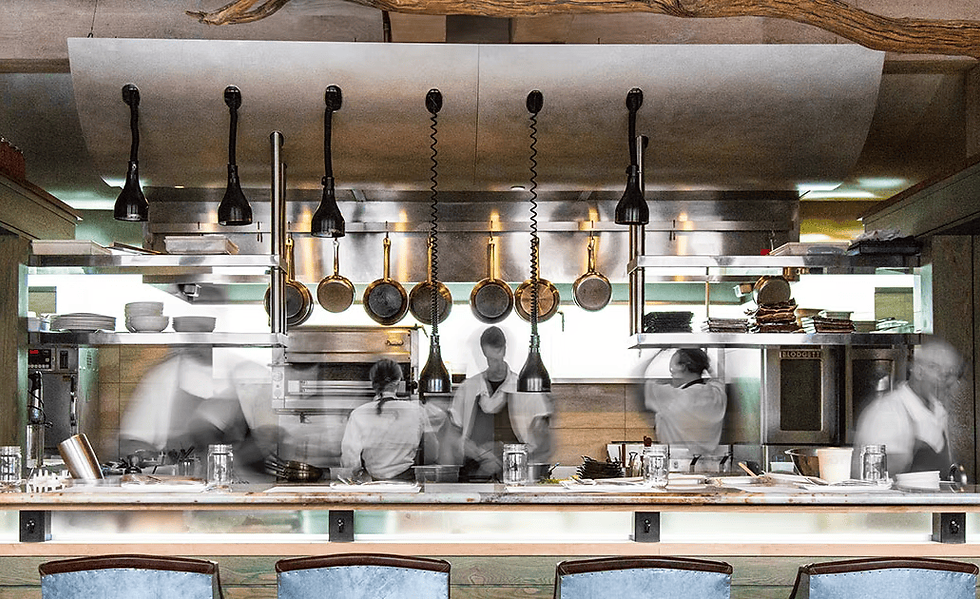6 Critical Mistakes to Avoid When Designing Your Restaurant Space
- brad2281
- Jun 1, 2023
- 2 min read
Updated: Aug 6
So you’ve found the perfect venue, nailed down your menu, and finalized your concept. Now it’s time to design the restaurant space and bring everything together.
But designing a restaurant isn't just about choosing tables and wall colors; it's about functionality, flow, safety, and operational efficiency. Even experienced restaurateurs fall into common traps that can lead to budget overruns, layout nightmares, or even safety issues.
Here are 6 restaurant design mistakes you need to avoid and how to do it right from the start.

1. Treating a Restaurant Kitchen Like a Home Kitchen
Home kitchens are built for one or two people. Restaurant kitchens? Not so much. In a commercial kitchen, you have multiple staff prepping, cooking, plating, and cleaning, all at once.
A poor layout can lead to traffic jams, wasted motion, broken equipment, and even injuries. Worse, it might not support your menu properly.
Smart Tip: Design your kitchen layout based on your workflow and food offerings. A sushi bar and a pizzeria won’t have the same space needs.
2. Underestimating Ventilation Requirements
Ventilation isn’t just about removing smoke or odors; it’s about health, comfort, and fire safety. Poorly ventilated kitchens overheat, cause air quality issues, and risk grease build-up.
While many new owners try to hide ductwork for aesthetics, cutting corners here can backfire hard.
3. Designing Like a Decorator, Not an Employee
That Instagram-worthy layout might look amazing, but if your team is tripping over chairs, squeezing through aisles, or bumping into each other behind the bar, it’s a problem.
Your design should work for employees, guests, and service flow.
4. Forgetting the Delivery Access
Where will your suppliers drop off inventory during a lunch rush? If you haven’t accounted for safe, separate delivery access, expect delays, disruptions, and a parade of boxes through your dining area.
Your guests should never notice when a delivery crew comes and goes.
5. Ignoring Noise Control
A busy kitchen is loud. Add in a packed dining room, and things can get chaotic, fast. Without proper acoustic planning, your restaurant can feel like a cafeteria.
6. Neglecting the Exterior and Entry Flow
Your restaurant’s design doesn’t stop at the walls. The exterior layout, signage, lighting, and parking flow all influence first impressions, safety, and daily operations.
Is your parking marked? Where are the trash bins? Are employees hauling waste past guests?
Mistakes in restaurant design don’t just impact aesthetics—they affect safety, workflow, guest satisfaction, and your bottom line. And once the walls go up, they’re expensive to change.
With ChefVue by LaBel Foodservice, you’ll co-create your layout in real time with expert designers via Zoom, getting feedback, adjusting plans, and avoiding costly missteps.




Fantastic insights! Designing a restaurant isn’t just about looks—it’s about functionality and customer comfort. That’s why I really admire how McDonald’s uses the McDVoice survey to constantly gather feedback. Through MCDVoice – Take Survey @ www.mcdvoice.com (Free Sandwich), they collect real-time input that helps refine their layout, noise levels, kitchen workflow, and even exterior areas. I recently read on McDTalks how this feedback loop shapes consistent improvements across their locations. A great reminder that thoughtful design and consumer feedback should go hand in hand for restaurant success. Thanks for breaking down these common pitfalls so clearly!